Abstract
The characterization of the source of the odor in the human axillary region is not only of commercial interest but is also important biologically because axillary extracts can alter the length and timing of the female menstrual cycle. In males, the most abundant odor component is known to be E-3-methyl-2-hexenoic acid (E-3M2H), which is liberated from nonodorous apocrine secretions by axillary microorganisms. Recently, it was found that in the apocrine gland secretions, 3M2H is carried to the skin surface bound to two proteins, apocrine secretion odor-binding proteins 1 and 2 (ASOB1 and ASOB2) with apparent molecular masses of 45 kDa and 26 kDa, respectively. To better understand the formation of axillary odors and the structural relationship between 3M2H and its carrier protein, the amino acid sequence and glycosylation pattern of ASOB2 were determined by mass spectrometry. The ASOB2 protein was identified as apolipoprotein D (apoD), a known member of the alpha2mu-microglobulin superfamily of carrier proteins also known as lipocalins. The pattern of glycosylation for axillary apoD differs from that reported for plasma apoD, suggesting different sites of expression for the two glycoproteins. In situ hybridization of an oligonucleotide probe against apoD mRNA with axillary tissue demonstrates that the message for synthesis of this protein is specific to the apocrine glands. These results suggest a remarkable similarity between human axillary secretions and nonhuman mammalian odor sources, where lipocalins have been shown to carry the odoriferous signals used in pheromonal communication.
Full text
PDF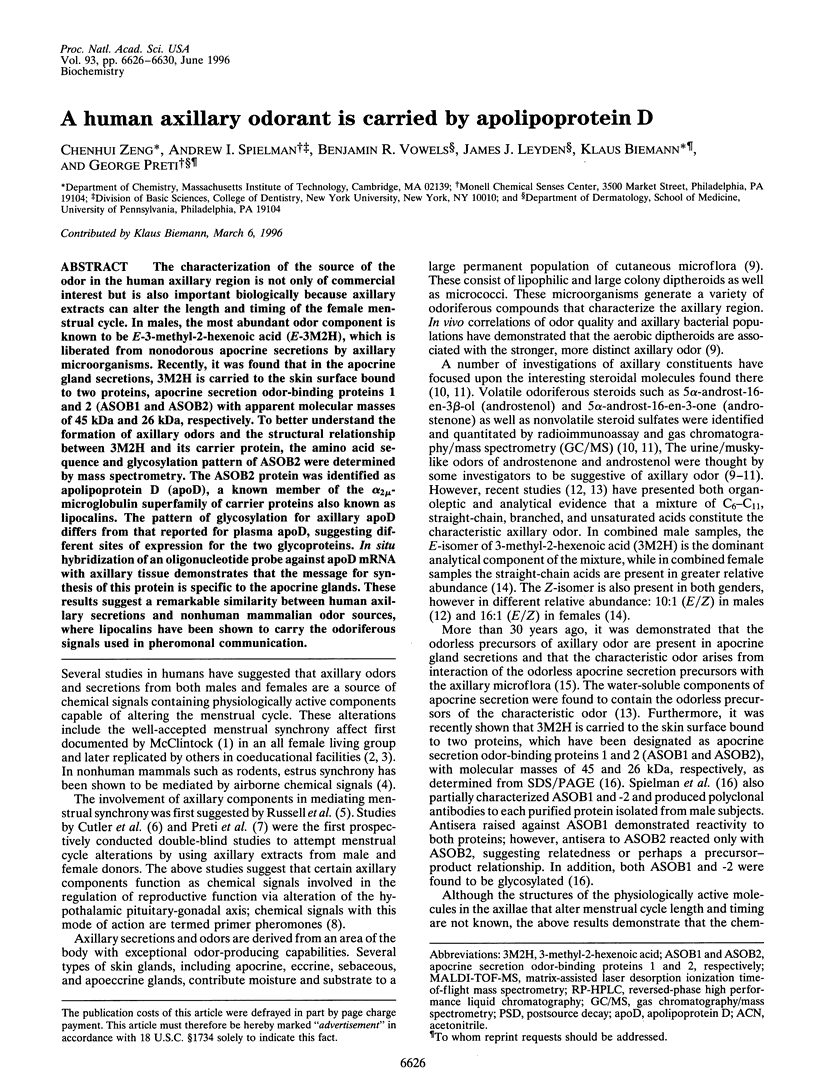
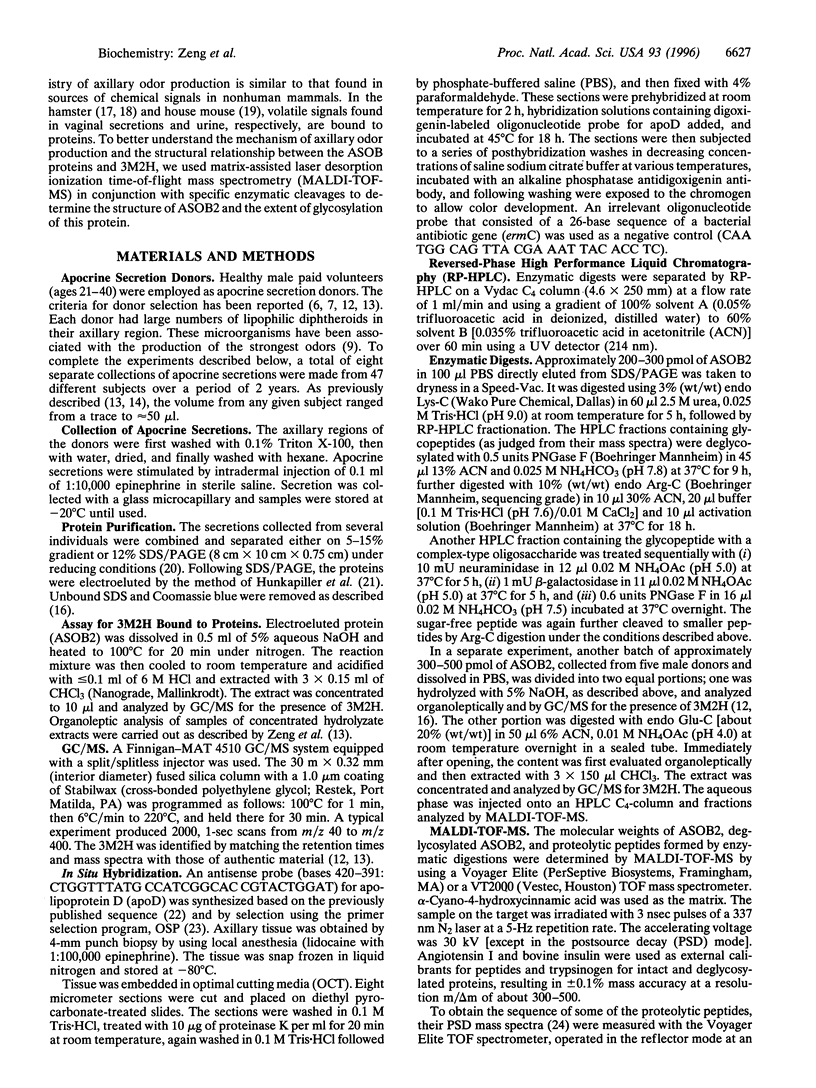
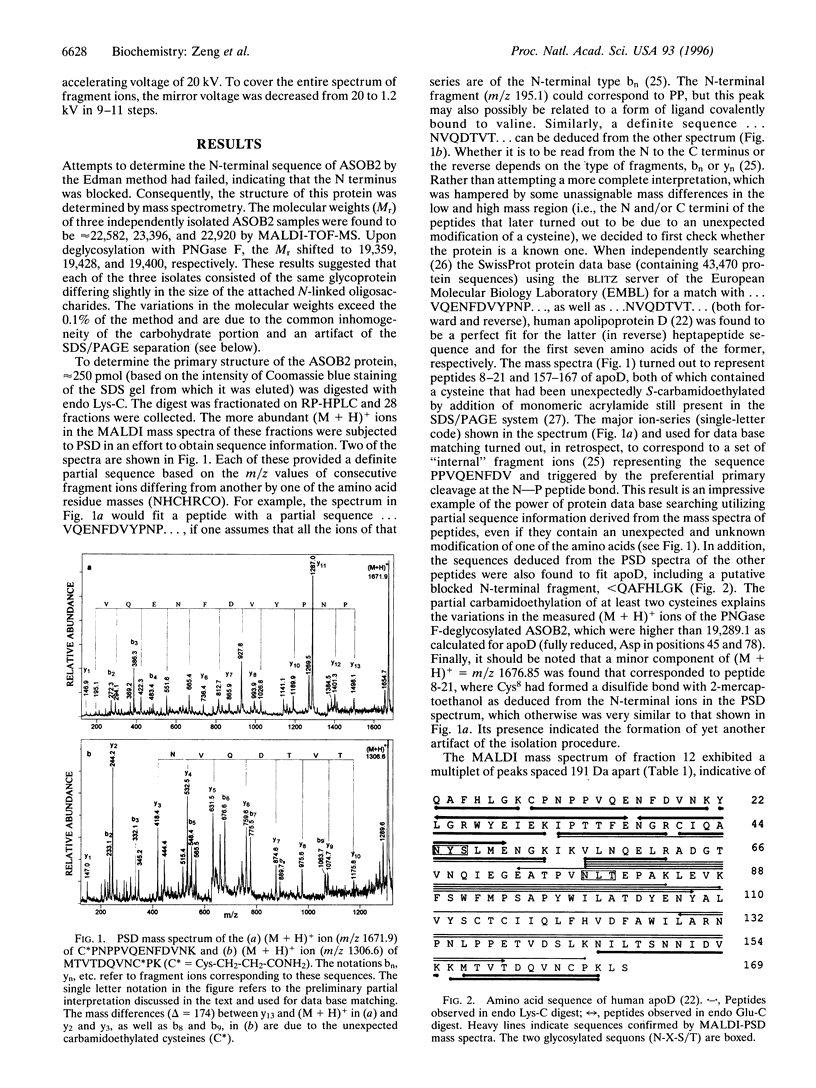
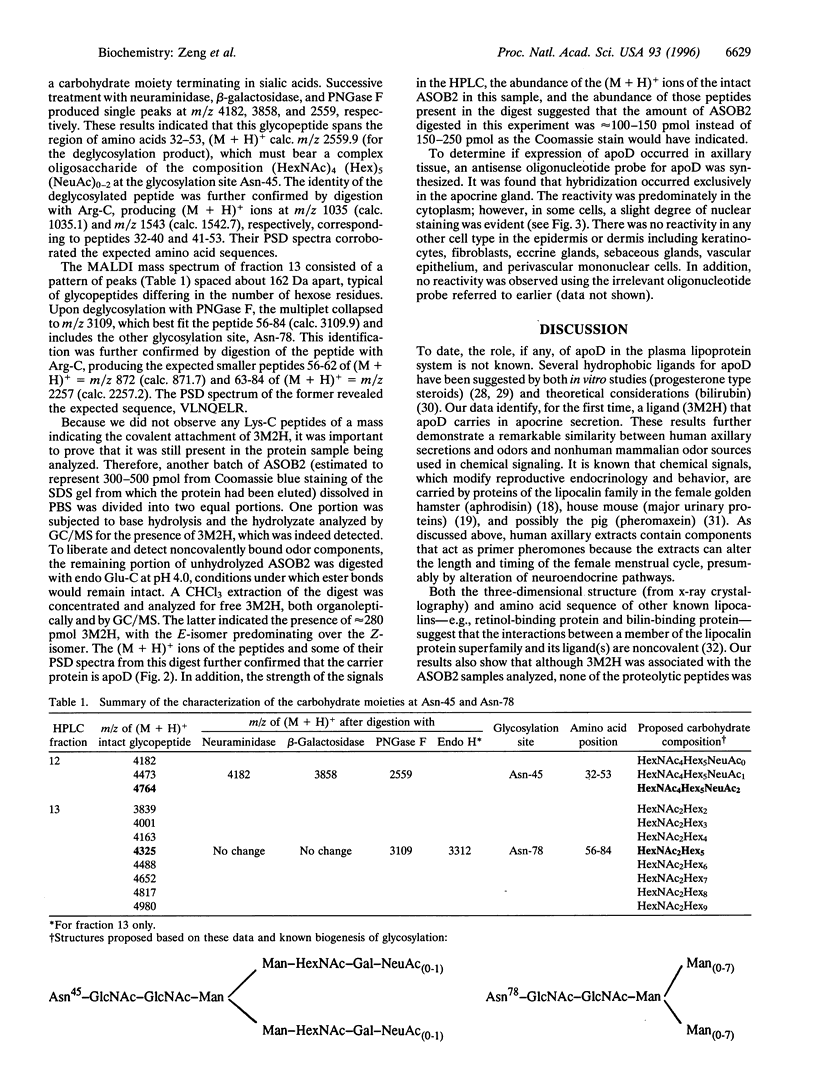
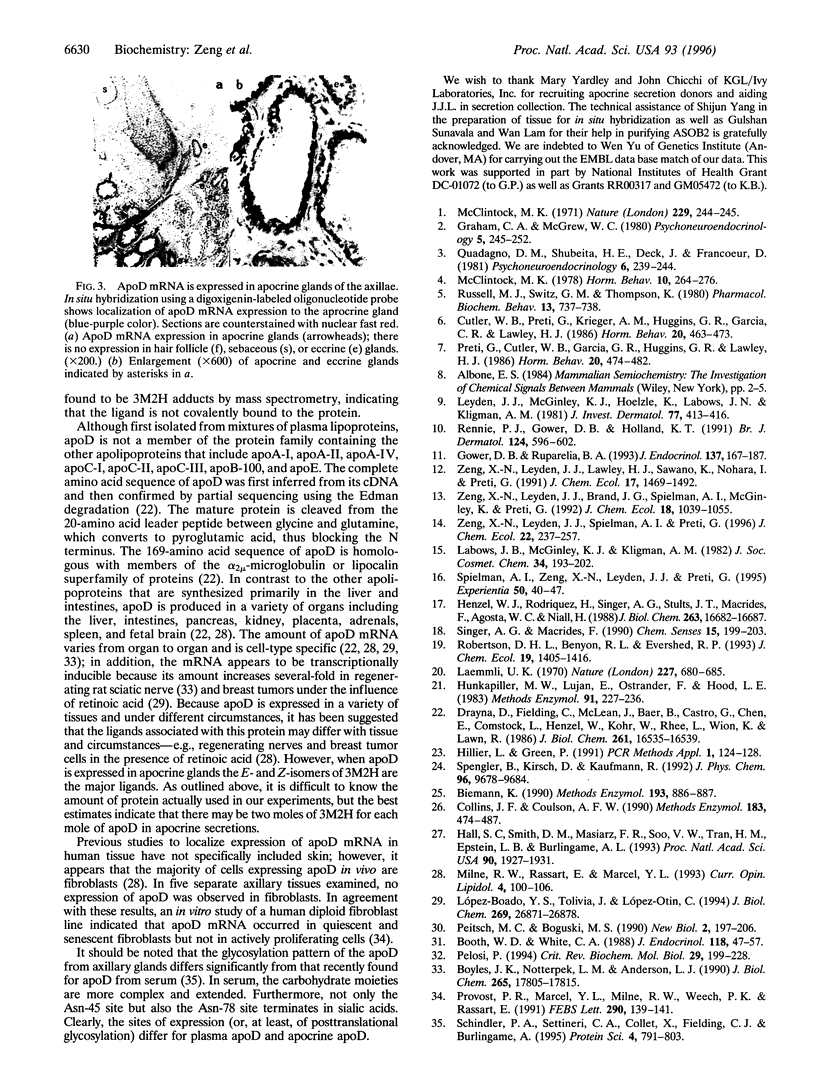
Images in this article
Selected References
These references are in PubMed. This may not be the complete list of references from this article.
- Biemann K. Appendix 5. Nomenclature for peptide fragment ions (positive ions). Methods Enzymol. 1990;193:886–887. doi: 10.1016/0076-6879(90)93460-3. [DOI] [PubMed] [Google Scholar]
- Booth W. D., White C. A. The isolation, purification and some properties of pheromaxein, the pheromonal steroid-binding protein, in porcine submaxillary glands and saliva. J Endocrinol. 1988 Jul;118(1):47–57. doi: 10.1677/joe.0.1180047. [DOI] [PubMed] [Google Scholar]
- Boyles J. K., Notterpek L. M., Anderson L. J. Accumulation of apolipoproteins in the regenerating and remyelinating mammalian peripheral nerve. Identification of apolipoprotein D, apolipoprotein A-IV, apolipoprotein E, and apolipoprotein A-I. J Biol Chem. 1990 Oct 15;265(29):17805–17815. [PubMed] [Google Scholar]
- Collins J. F., Coulson A. F. Significance of protein sequence similarities. Methods Enzymol. 1990;183:474–487. doi: 10.1016/0076-6879(90)83032-5. [DOI] [PubMed] [Google Scholar]
- Cutler W. B., Preti G., Krieger A., Huggins G. R., Garcia C. R., Lawley H. J. Human axillary secretions influence women's menstrual cycles: the role of donor extract from men. Horm Behav. 1986 Dec;20(4):463–473. doi: 10.1016/0018-506x(86)90008-5. [DOI] [PubMed] [Google Scholar]
- Drayna D., Fielding C., McLean J., Baer B., Castro G., Chen E., Comstock L., Henzel W., Kohr W., Rhee L. Cloning and expression of human apolipoprotein D cDNA. J Biol Chem. 1986 Dec 15;261(35):16535–16539. [PubMed] [Google Scholar]
- Gower D. B., Ruparelia B. A. Olfaction in humans with special reference to odorous 16-androstenes: their occurrence, perception and possible social, psychological and sexual impact. J Endocrinol. 1993 May;137(2):167–187. doi: 10.1677/joe.0.1370167. [DOI] [PubMed] [Google Scholar]
- Graham C. A., McGrew W. C. Menstrual synchrony in female undergraduates living on a coeducational campus. Psychoneuroendocrinology. 1980;5(3):245–252. doi: 10.1016/0306-4530(80)90028-1. [DOI] [PubMed] [Google Scholar]
- Hall S. C., Smith D. M., Masiarz F. R., Soo V. W., Tran H. M., Epstein L. B., Burlingame A. L. Mass spectrometric and Edman sequencing of lipocortin I isolated by two-dimensional SDS/PAGE of human melanoma lysates. Proc Natl Acad Sci U S A. 1993 Mar 1;90(5):1927–1931. doi: 10.1073/pnas.90.5.1927. [DOI] [PMC free article] [PubMed] [Google Scholar]
- Henzel W. J., Rodriguez H., Singer A. G., Stults J. T., Macrides F., Agosta W. C., Niall H. The primary structure of aphrodisin. J Biol Chem. 1988 Nov 15;263(32):16682–16687. [PubMed] [Google Scholar]
- Hillier L., Green P. OSP: a computer program for choosing PCR and DNA sequencing primers. PCR Methods Appl. 1991 Nov;1(2):124–128. doi: 10.1101/gr.1.2.124. [DOI] [PubMed] [Google Scholar]
- Hunkapiller M. W., Lujan E., Ostrander F., Hood L. E. Isolation of microgram quantities of proteins from polyacrylamide gels for amino acid sequence analysis. Methods Enzymol. 1983;91:227–236. doi: 10.1016/s0076-6879(83)91019-4. [DOI] [PubMed] [Google Scholar]
- Laemmli U. K. Cleavage of structural proteins during the assembly of the head of bacteriophage T4. Nature. 1970 Aug 15;227(5259):680–685. doi: 10.1038/227680a0. [DOI] [PubMed] [Google Scholar]
- Leyden J. J., McGinley K. J., Hölzle E., Labows J. N., Kligman A. M. The microbiology of the human axilla and its relationship to axillary odor. J Invest Dermatol. 1981 Nov;77(5):413–416. doi: 10.1111/1523-1747.ep12494624. [DOI] [PubMed] [Google Scholar]
- López-Boado Y. S., Tolivia J., López-Otín C. Apolipoprotein D gene induction by retinoic acid is concomitant with growth arrest and cell differentiation in human breast cancer cells. J Biol Chem. 1994 Oct 28;269(43):26871–26878. [PubMed] [Google Scholar]
- McClintock M. K. Estrous synchrony and its mediation by airborne chemical communication (Rattus norvegicus). Horm Behav. 1978 Jun;10(3):264–275. doi: 10.1016/0018-506x(78)90071-5. [DOI] [PubMed] [Google Scholar]
- McClintock M. K. Menstrual synchorony and suppression. Nature. 1971 Jan 22;229(5282):244–245. doi: 10.1038/229244a0. [DOI] [PubMed] [Google Scholar]
- Peitsch M. C., Boguski M. S. Is apolipoprotein D a mammalian bilin-binding protein? New Biol. 1990 Feb;2(2):197–206. [PubMed] [Google Scholar]
- Pelosi P. Odorant-binding proteins. Crit Rev Biochem Mol Biol. 1994;29(3):199–228. doi: 10.3109/10409239409086801. [DOI] [PubMed] [Google Scholar]
- Preti G., Cutler W. B., Garcia C. R., Huggins G. R., Lawley H. J. Human axillary secretions influence women's menstrual cycles: the role of donor extract of females. Horm Behav. 1986 Dec;20(4):474–482. doi: 10.1016/0018-506x(86)90009-7. [DOI] [PubMed] [Google Scholar]
- Provost P. R., Marcel Y. L., Milne R. W., Weech P. K., Rassart E. Apolipoprotein D transcription occurs specifically in nonproliferating quiescent and senescent fibroblast cultures. FEBS Lett. 1991 Sep 23;290(1-2):139–141. doi: 10.1016/0014-5793(91)81244-3. [DOI] [PubMed] [Google Scholar]
- Quadagno D. M., Shubeita H. E., Deck J., Francoeur D. Influence of male social contacts, exercise and all-female living conditions on the menstrual cycle. Psychoneuroendocrinology. 1981;6(3):239–244. doi: 10.1016/0306-4530(81)90033-0. [DOI] [PubMed] [Google Scholar]
- Rennie P. J., Gower D. B., Holland K. T. In-vitro and in-vivo studies of human axillary odour and the cutaneous microflora. Br J Dermatol. 1991 Jun;124(6):596–602. doi: 10.1111/j.1365-2133.1991.tb04958.x. [DOI] [PubMed] [Google Scholar]
- Russell M. J., Switz G. M., Thompson K. Olfactory influences on the human menstrual cycle. Pharmacol Biochem Behav. 1980 Nov;13(5):737–738. doi: 10.1016/0091-3057(80)90020-9. [DOI] [PubMed] [Google Scholar]
- Schindler P. A., Settineri C. A., Collet X., Fielding C. J., Burlingame A. L. Site-specific detection and structural characterization of the glycosylation of human plasma proteins lecithin:cholesterol acyltransferase and apolipoprotein D using HPLC/electrospray mass spectrometry and sequential glycosidase digestion. Protein Sci. 1995 Apr;4(4):791–803. doi: 10.1002/pro.5560040419. [DOI] [PMC free article] [PubMed] [Google Scholar]
- Spielman A. I., Zeng X. N., Leyden J. J., Preti G. Proteinaceous precursors of human axillary odor: isolation of two novel odor-binding proteins. Experientia. 1995 Jan 15;51(1):40–47. [PubMed] [Google Scholar]



